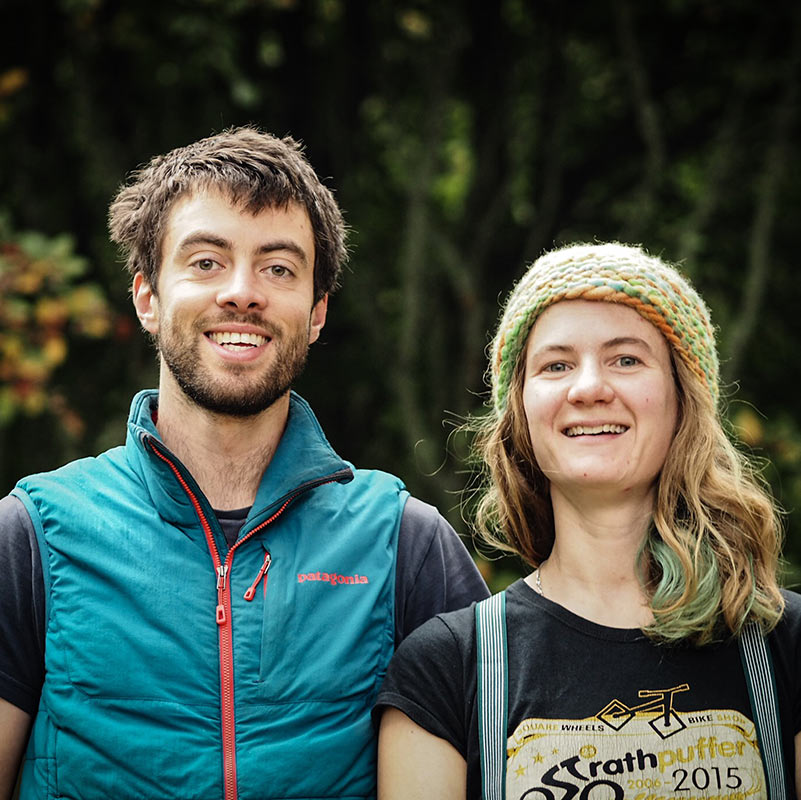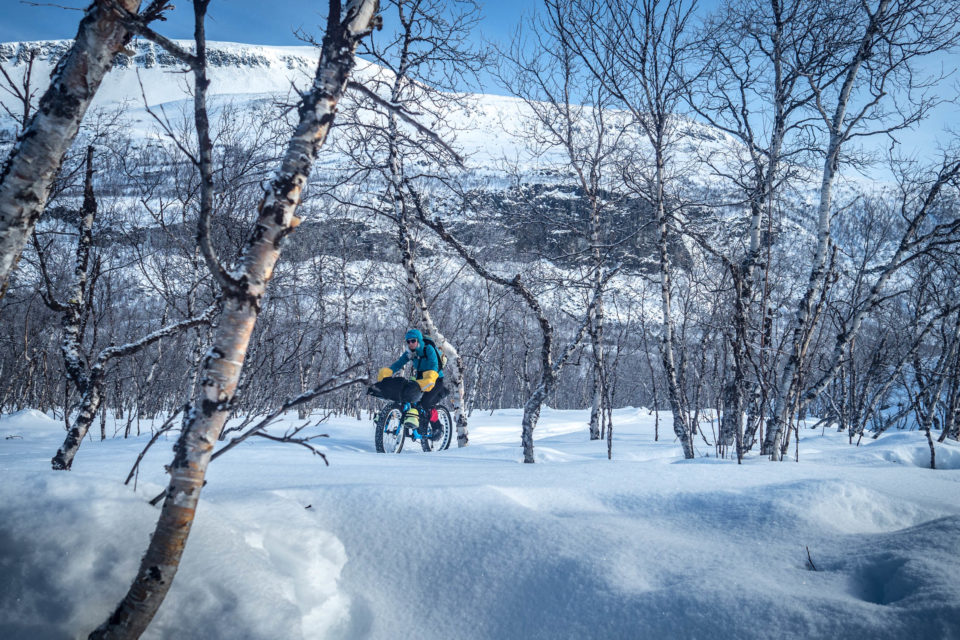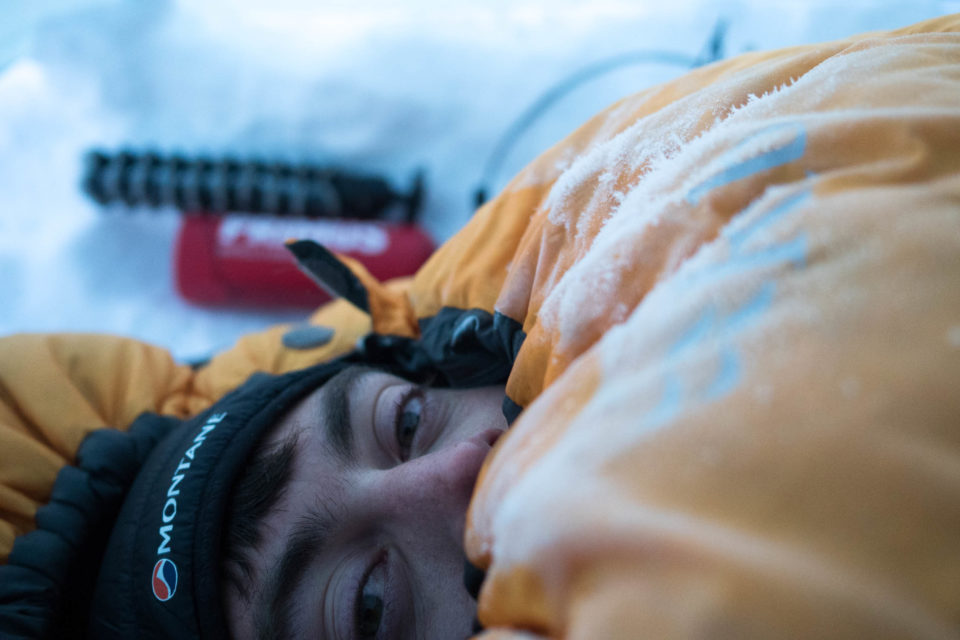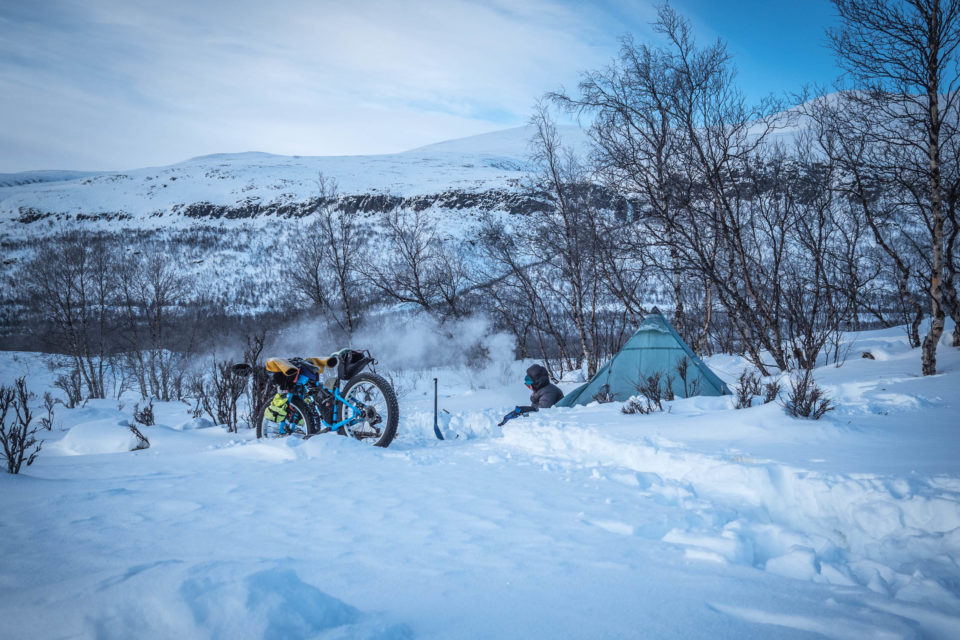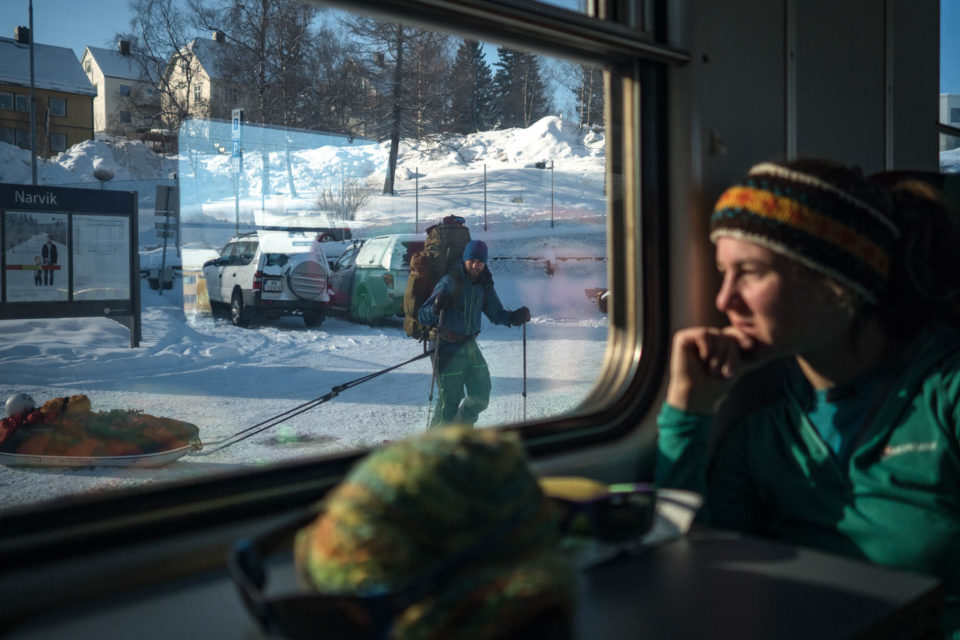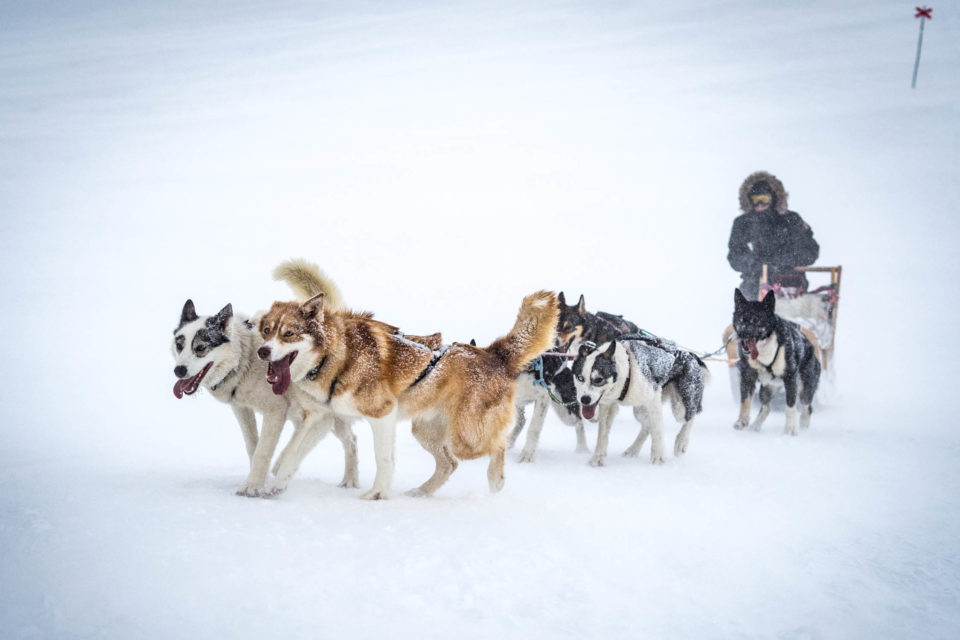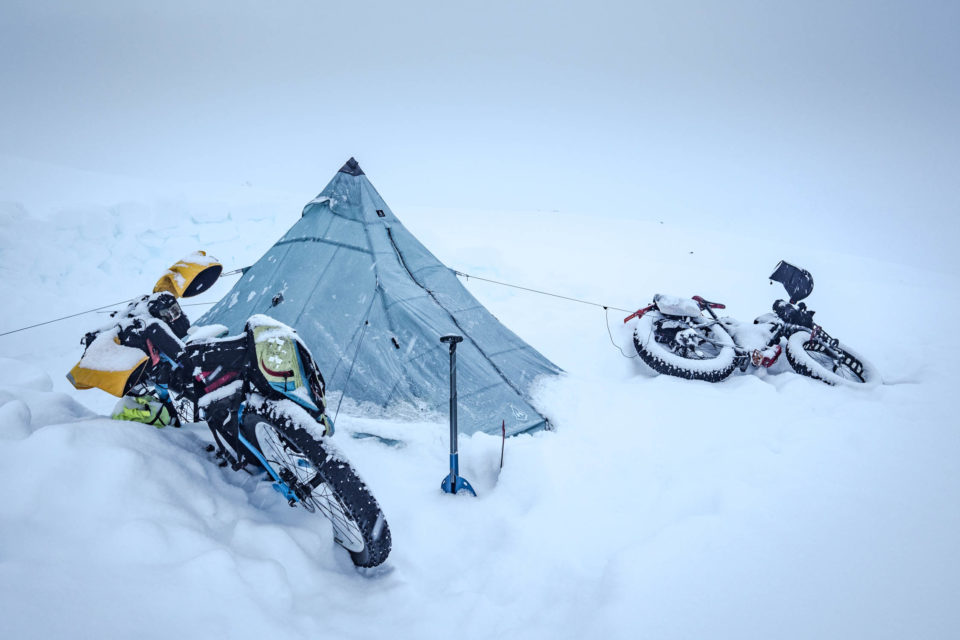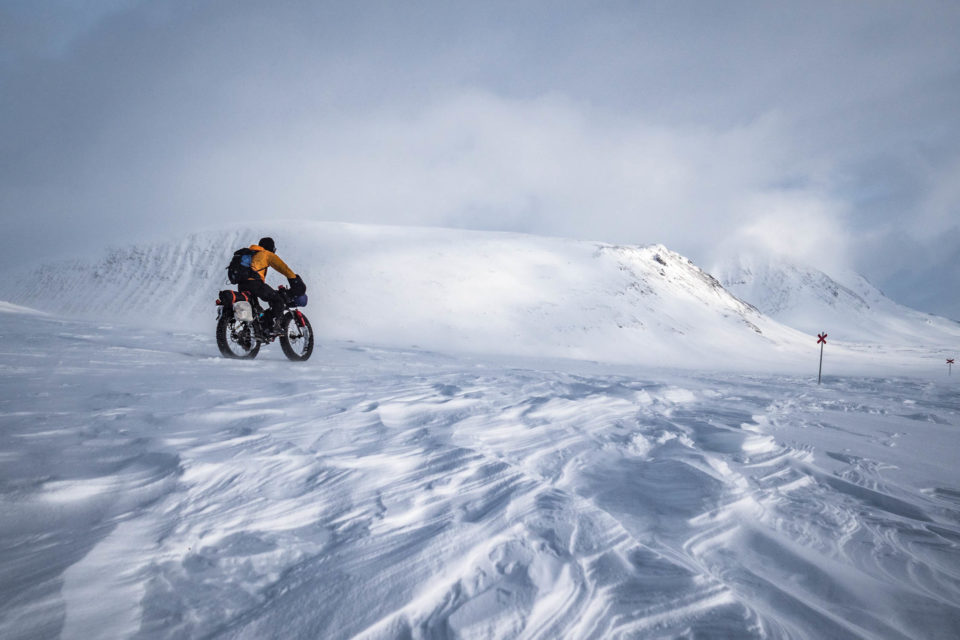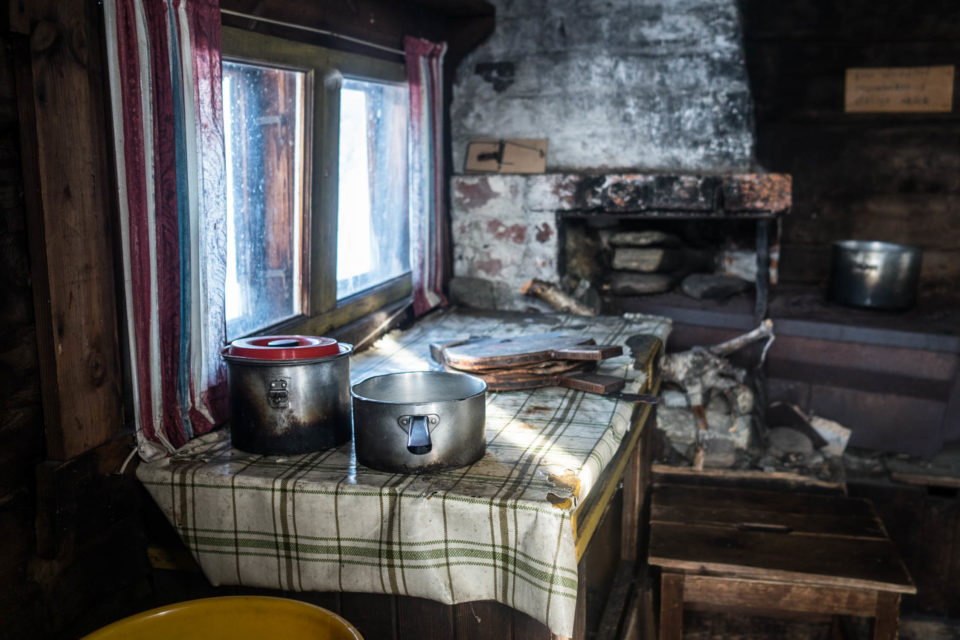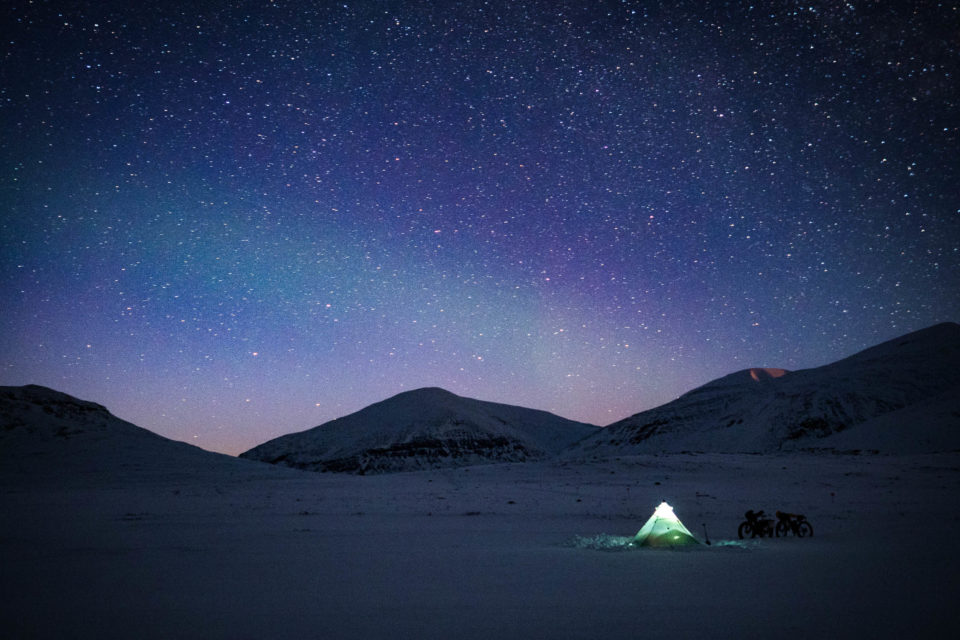Fat Tyres and Friluftsliv: Bikepacking Lapland
Share This
Huw Oliver and Annie Le pedaled their fatbikes through remote and mountainous snowscapes north of the Arctic Circle in hopes of better understanding “friluftsliv,” the philosophy of embracing open-air living. Read on for a story of attempting to find joy in being outdoors, despite the impossibly cold conditions…
Words and photos by Huw Oliver (@topofests) and Annie Le (@a_girl_outside)
I looked again at the map, at the confident lines that we had traced across its surface a few days before, lines that now more closely resembled a rod for our own backs. As time to think was plentiful, I asked myself how I had once again come to this familiar position: lying in a tent somewhere cold, trying to ride (mostly push, actually) a very heavy bike, all contrary to popular opinion on whether it was likely to be fun.
As I rolled over in the tent I was grateful, at least, for the veneer of warmth provided by my sleeping bag. Crystals of my own frozen breath fell from the fabric around my face and travelled a surprisingly long way up my nose before melting with an unpleasant tickle. I couldn’t tell you why, and I’m surely not alone, but as I kid I was drawn to the edges, to try and find a little space that no one else knew about. A lot of kids want to explore away from the eyes of the people that tell them what to do; I’d bet that it’s what led a good many of us down the enlightened road towards pedal-powered liberation.
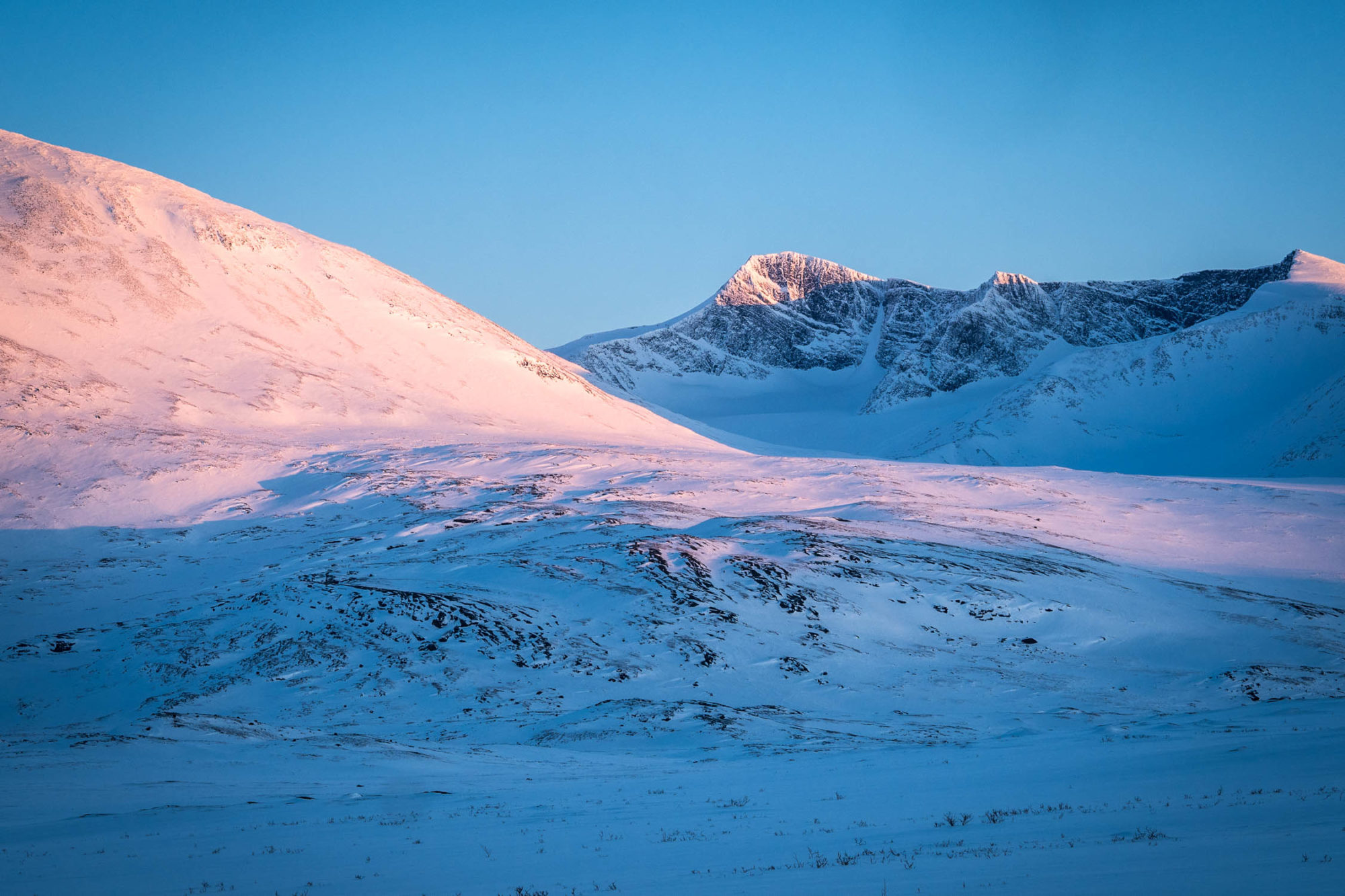
Right now, that road had brought us a couple of hundred kilometres north of the Arctic Circle, close enough to the mostly unmarked Norwegian border that I would see it in the morning, listening to the wind sheeting down from the glaciers above and softly rattling the tent wall somewhere near my ear. Annie is next to me, asleep in her own heavily insulated down cocoon, but I’m lying here awake, not trying to work out whether I am enjoying this, but rather why I’m enjoying it.
Perhaps if I’d grown up in Sweden, I would have learned the word friluftsliv (‘open-air living’) earlier. It’s a common concept in Scandinavia, and it simply expresses the joys of being outdoors. From the moment we hauled bulky bike boxes onto the train across the border in Norway, no one batted an eyelid at our idea of riding bikes on the winter trails that usually belong solely to nordic skis and snowmobiles. I suppose that the guy hauling a pulka along the station platform in Narvik spelled out that we had arrived somewhere that the outdoors are meant to be enjoyed. It might just have been Scandinavian cool, but even the train conductor agreed that a fatbike trip sounded good. Asking after our enormous boxes and what we planned to do, he thought over our answer for a second before smiling and replying with a laconic “why not?” And with that, it became a bit of a refrain.
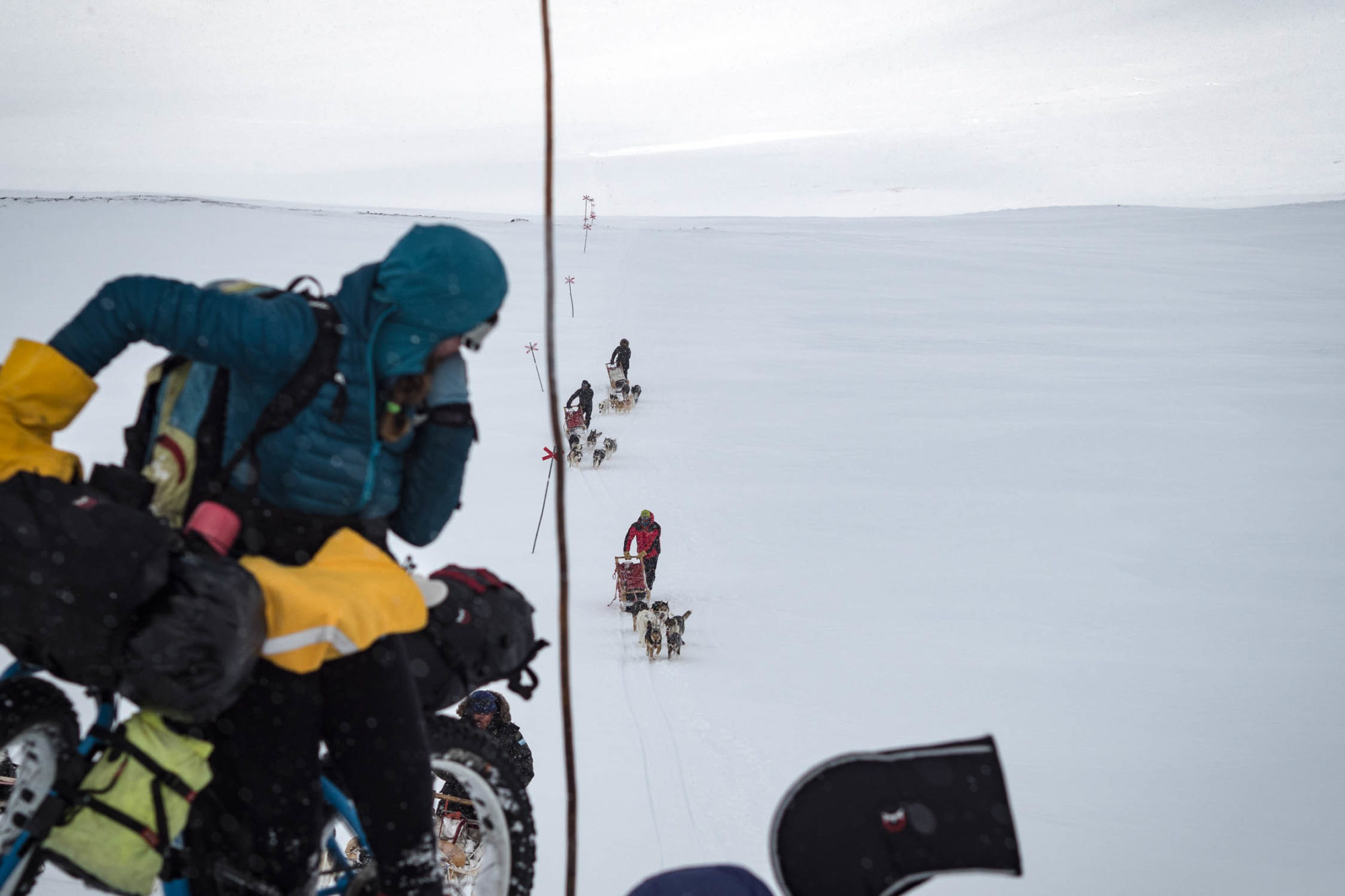
The first few days of any trip feel the same: long, slow, savoured exhalation, sinking backwards into the simple rhythm of daily routine as you would sink into a warm bath. From the scruffy forest of twisted pines around Abisko, the ground ramps gradually upwards along the Abiskojokka to where it flows out of the lake at Abiskojaure. As it climbs, the trees lining either side of the winter trail soon change to dense birch, punctuated by clearings as it crosses frozen swamps. We spent a few days in the area, falling into the rhythm of the Arctic days and hoping to reach an understanding of the Arctic nights. A Scottish winter is a poor imitation of higher latitudes: the comfortable warmth of spring sunshine was countered by the bitter cold of the night, when the temperature dipped to around -20 Celsius and my hands protested at even simple tasks. Still, in a place that can appear outwardly to be so unaccommodating to humans, the simplest acts – pitching the tent or making a cup of tea – offered a kind of reward of their own.

The Kungsleden is a popular trail in both winter and summer, cutting an efficient track through the elongated glacial troughs that scores lines right through the mountains of northern Sweden. Being so reliant on compacted trails, given the recent 50cm snowfall, we planned to follow it south and determine what else might be possible in the conditions that we encountered. In a way, it epitomises the pragmatic Swedish approach to the outdoors, as there are well-serviced huts at 10 to 20 kilometre intervals, but these somehow do little to detract from the magnificent, blasted emptiness of the interior.
We packed the panniers and frame bags to bursting with ten days of supplies back in Abisko. Fresh snow had blown in overnight, obliterating most of the pre-existing tracks, so we climbed out of town for the second time in the low-contrast, grey purgatory of ominous cloud and the cotton wool silence of falling snow. Snow is never dull: beneath the hypnotic rumble of the tyres as they rolled up the trail were all the buried nuances of the tracks that the snow had covered: the staccato bobbles of dog tracks, firm ski tracks, and the pockets of soft snow left behind where snowmobiles had revved too hard and dug in, waiting like traps for fatbike tyres. It has a history of its own that needs to be read and understood, but right now the first chapter was a topping of momentum-sapping fresh drifts that got worse as we slowly ascended.
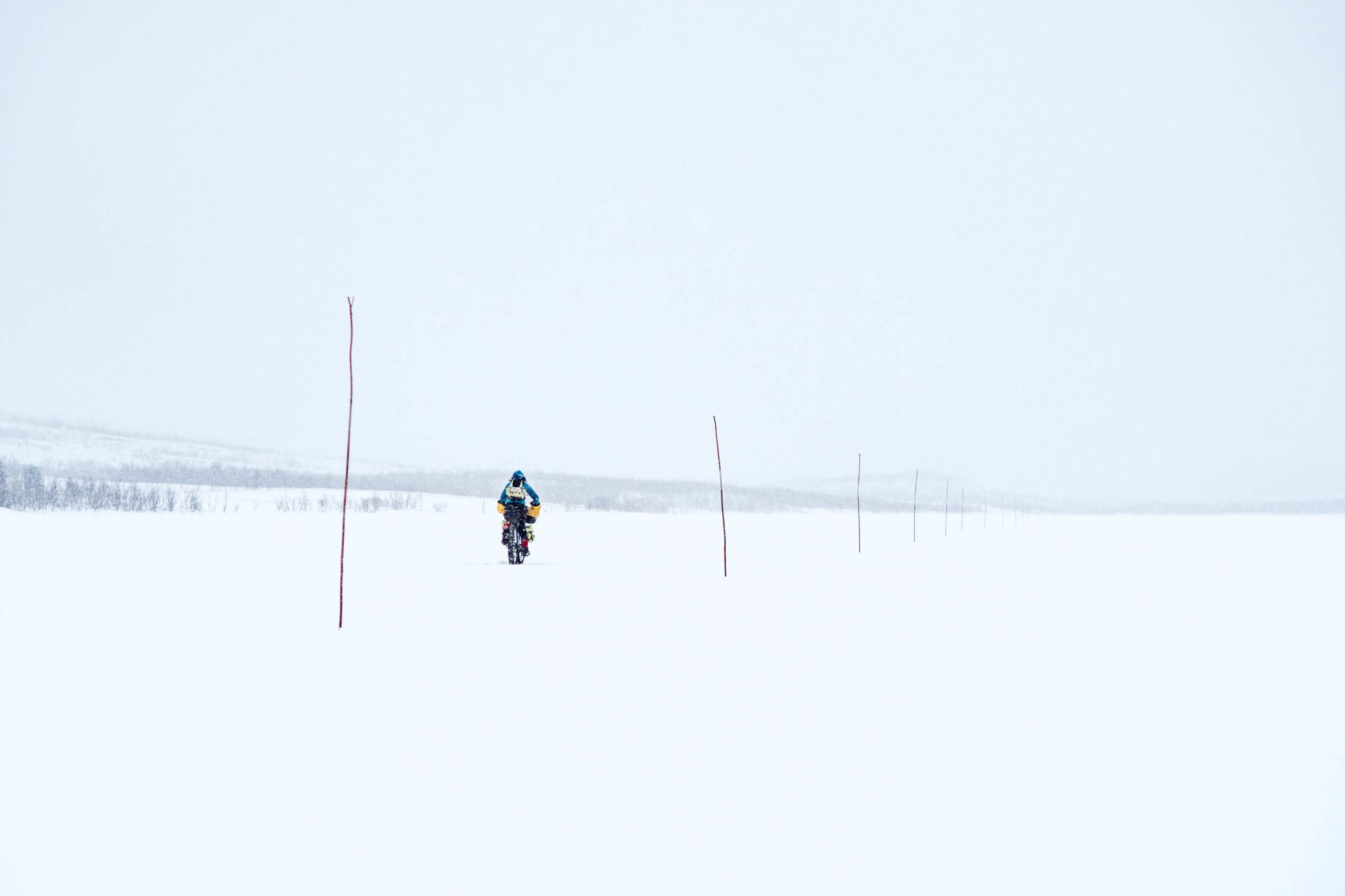
The first major climb from Abiskojaure leaves the birch forest for the mountain plateaus, following the regular red-crossed markers that provide the scene’s only colour. We hoped that the forecast had accurately predicted the snow to stop falling sometime soon. It did, but the damage was done. What began as an inconvenient blanket of snow over the trail became three days of mostly pushing through soft windslab that was so very nearly rideable, but so frustratingly not. There seemed to be too few skiers to put in a fresh track, and as we passed the first two mountain huts with their cohorts of happy skiers relaxing inside after a day’s travel, both our means of transport and choice of accommodation seemed questionable. Unfortunately, I also chose this moment to try a fat-based diet of nuts and cheese. Great in theory, but pushing a loaded bike through snow is hard work, and my body can’t burn fats quickly enough to meet demand. The result was some of the most spectacular mood crashes of my life, which only the life-saving powers of frozen sweets were able to remedy.
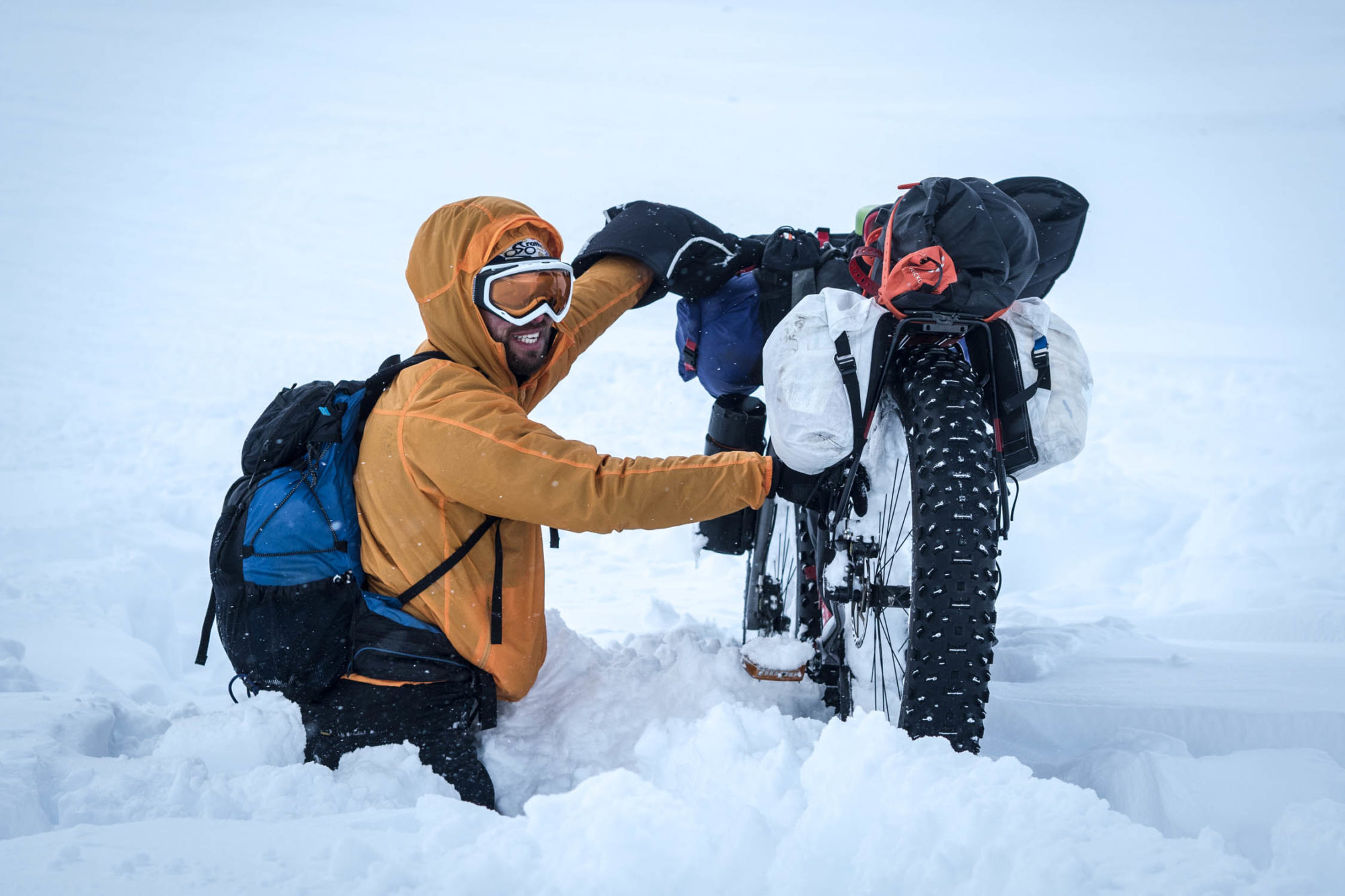
So, there we were, lying dozing in that tent as more fresh snow fell on Tjaktja Pass above us, which we were due to cross the next morning. The discovery that my body prefers some nice stodgy carbohydrates had lifted me out of the fug of sugar-deprivation long enough to consider the self-inflicted situation we found ourselves in. The problem was, I was loving it. In the morning, we would melt snow for tea and porridge, pack our few possessions quickly before the cold seeped into our bodies, and continue crossing these wild, white, wonderful mountains. Every feature of the monochrome landscape fascinated me. The striated, frozen waves of the wind-scoured snow; the glaciers, briefly spotted peering down from their cloak of cloud like inquisitive giants; even the percussive shock of the cold on my nose and the impermanence of my own body heat, protected by flimsy layers of nylon and down. That being said, we were both knackered, and with the unspoken understanding of two people who have travelled together before, we understood that the continuing snow might signal the end of any aspirations we had to complete a route through the mountains.
As if it was a test, once we crossed Tjaktja Pass the world became more sympathetic to the rolling wheel; having been the slowest moving things for days, suddenly we were one of the fastest. The valleys surrounding Sweden’s highest summit, Kebnekaise, were carved deep and narrow by passing ice, and the wind whipping through them had kept the snow moving, leaving a firm, scoured surface that gave great riding for tired legs. Soon enough we had passed the busy mountain station at Kebnekaise itself, and ‘Plan A’ was completed as we arrived further down the valley at the Sami settlement of Nikkaluokta.
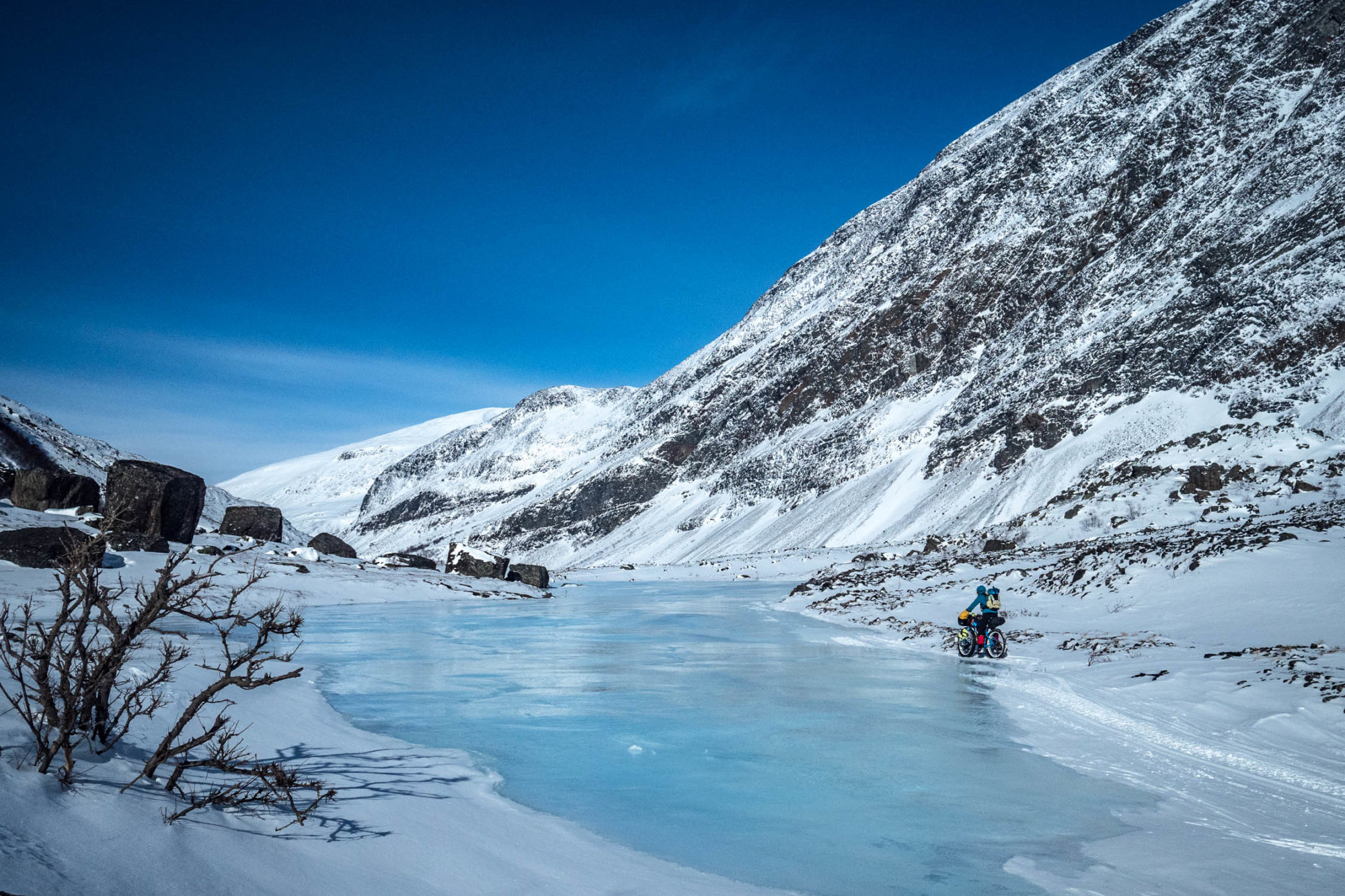
The Sami are Europe’s last nomadic people, having more or less survived in Lapland despite centuries of familiar persecution from settled European peoples. They split their time between winter settlements and summer villages in the mountains, mirroring the seasonal migration of the reindeer that form the central pillar of their existence. The history of their people is a long story in itself, but the modern Sami make use of both the old and the new – we saw them daily on the trail, often passing us on skidoos while wearing homemade, reindeer skin mittens or finneskoe boots. We saw those skidoos parked up outside the low, traditional turf huts, and the Sami reindeer corrals marked on our maps might have been in use for centuries (but not longer, the Sami only made the switch from hunting to semi-domesticating their reindeer around 500 years ago).
The Sami were beginning to move equipment and supplies up to the summer villages in the mountains, so we hoped to make the most of the traffic on those trails to take another route through the mountains by following the long Vistasvaggi valley back north. Its swampy summertime conditions make for a great winter trail, one that follows swamps and the meandering river through miles of silver birch forest. Away from the busier Kungsleden trail, the silence was complete, and aside from the occasional skier, the company came mostly in the form of moose, half-seen while stalking on spindly legs through the nearby forest.
At Vistasstuga hut, we couldn’t resist the lure of a hot iron stove by which to dry boots and socks, so we followed the smell of wood smoke off the main trail, and dropped in for a cup of tea to escape a particularly cold morning. The hut guardian was warm and welcoming, an older woman who viewed the running of the hut as the ideal retirement job now that she couldn’t hike so far, as it allowed her to spend time in the mountains. In truth, we enjoyed the fuss that she made of us when we said that we were camping, as well as the warm tea and spot by the stove. She warned us not to get cold at night, all while strapping on a spectacular cross-country ski getup last seen in the wild in 1984, and skating off for her morning ski before that night’s guests arrived with tired legs and empty stomachs.
If anything, the attitudes of the Swedes we met made us more confident in our reasons for camping. Although it was born of necessity (as nice as they are, there was no way our budget was allowing us to stay in the huts when we passed them) we craved the personal satisfaction of learning how to look after ourselves in a new environment, rather than self-imposed hardship. We weren’t the only people choosing to camp, and the general noises of approval we encountered along the way reinforced our appreciation of the Swedish love affair with their open spaces. Almost everyone we met, whether on a snowmobile, snowshoes, or skis, was curious about why we would bike here where the ski was king, but none were overtly sceptical. The artless smiles and red cheeks spoke only in recognition of the simple good that wide spaces and a cold breeze can do for the soul.
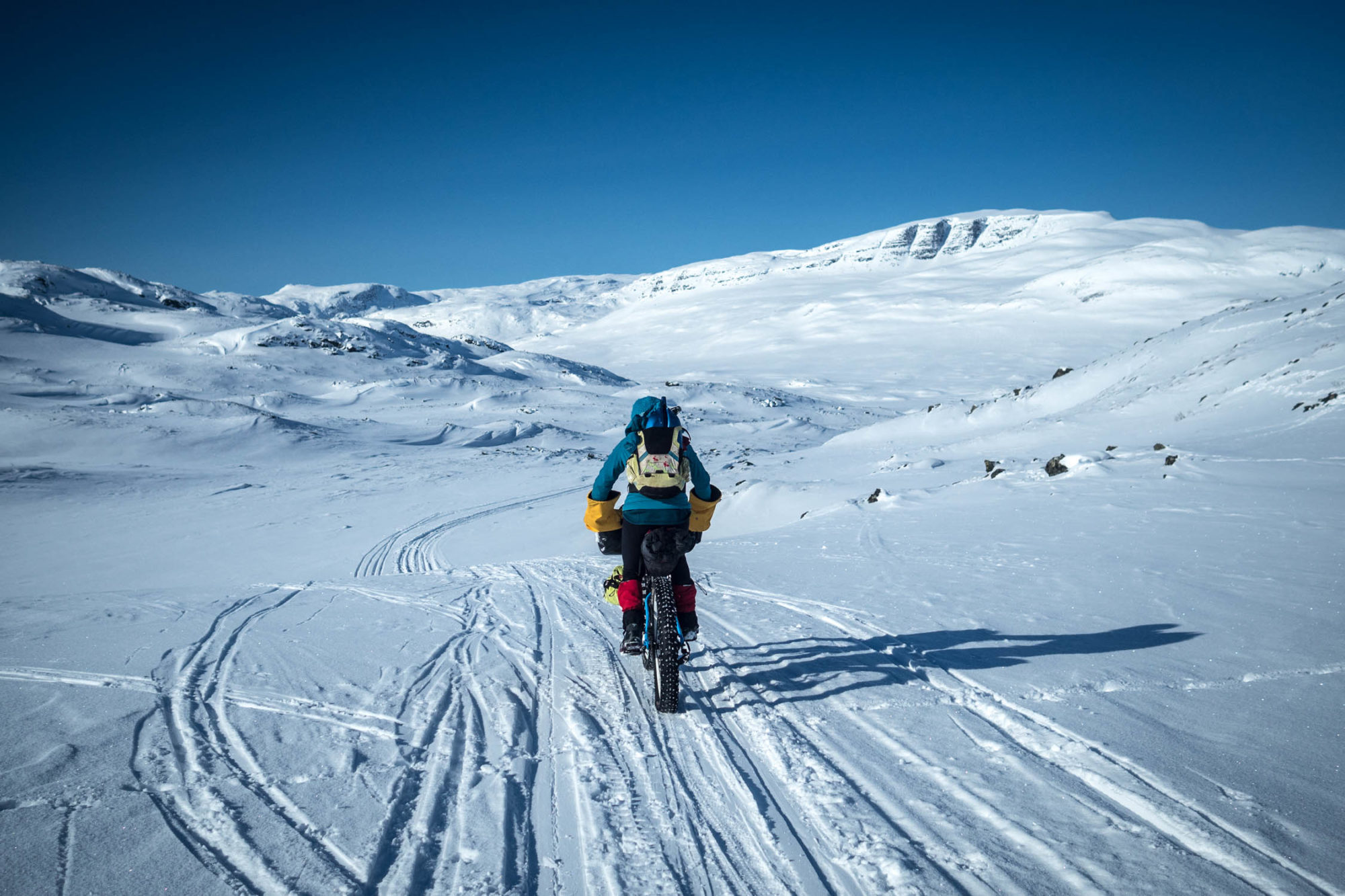
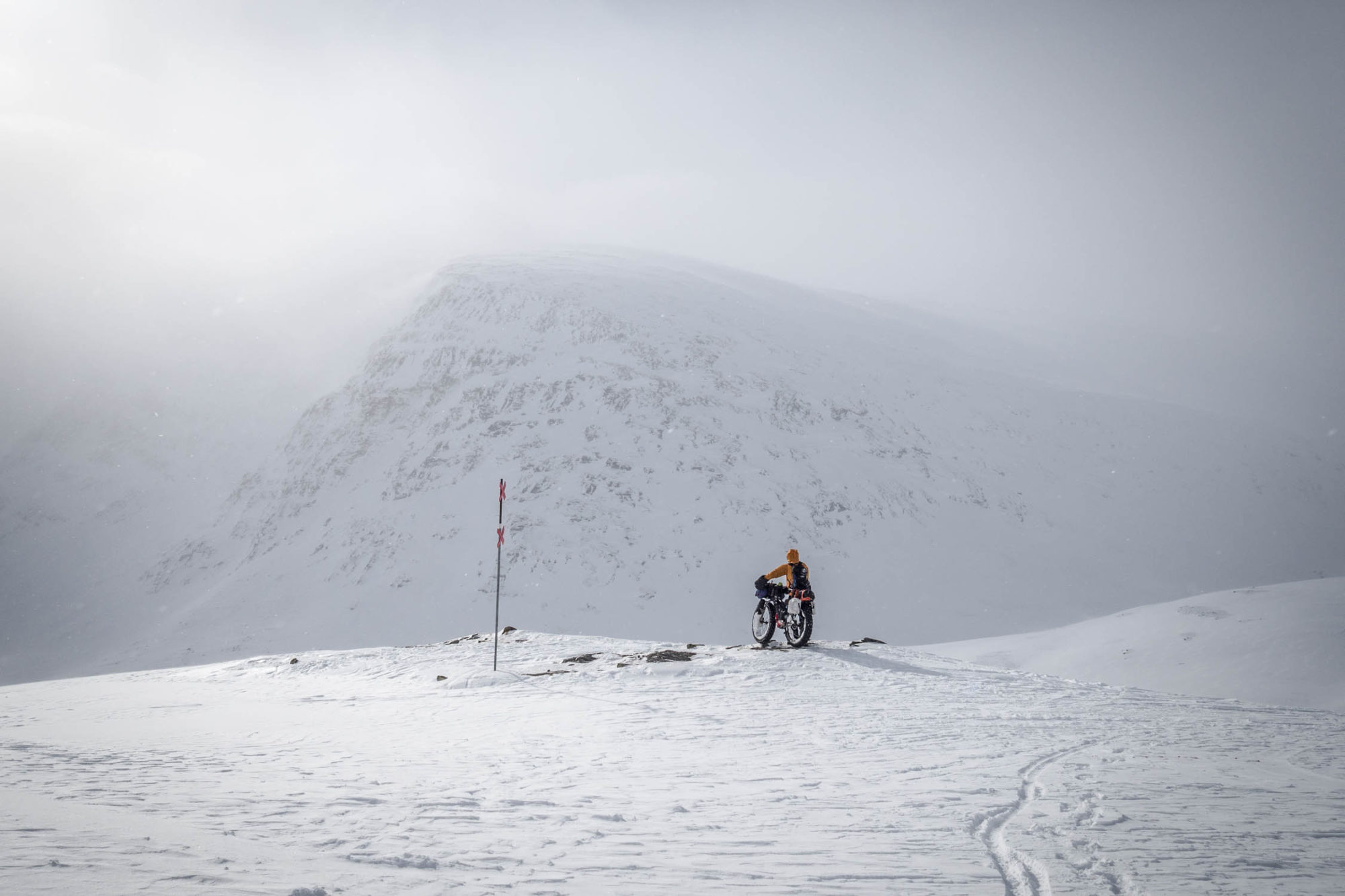
Back at home, conversations about human-powered journeys usually revolve around perceived hardships, or a desire to get away from it all, whatever ‘it’ might be. The people we met on the trail and in the huts were young and old, male and female. Some were serious about their outdoor sports, and some were hauling pulkas full of wine and cheese in order to take that evening’s rest and recuperation more seriously instead. They weren’t escaping from other people, but manifesting a shared need to experience their country’s vast outdoor space. I doubt that I need to explain the value of space to the people reading this, of solitude and room to breathe outdoors; once experienced, it is understood forever. ‘Pilgrimage’ is perhaps the wrong word, but it’s the first one that comes to mind when describing the Swedes we met and their approach to making journeys in the Arctic. What a thought, to have met an entire country for whom the value of distant horizons and room to think is self-evident and self-justifying. If I sound smitten, it’s because I am.
Vistasvaggi finally petered out into another plateau, another plain of white spread out to another crenulated horizon. It was easy to forget the stress of the planning at home, the hours spent dissecting maps, blogs, and climate statistics in order to gauge whether it was likely to even work. When you’re submerged in the rhythm of a journey, it tends to be distinct images and moments – the patterns of wind-blown snow, a sunset watched through a tent door, or the merry dancers of the northern lights – that form a constellation of little memories when the journey is done. The wind dropped for a second, leaving little else but snow, cold-cleansed rock, and the sound of freezing air in our throats. Before we arrived in Sweden, I would have struggled to describe where the happiness in that moment came from. Since then, though, I think I have just the right word.
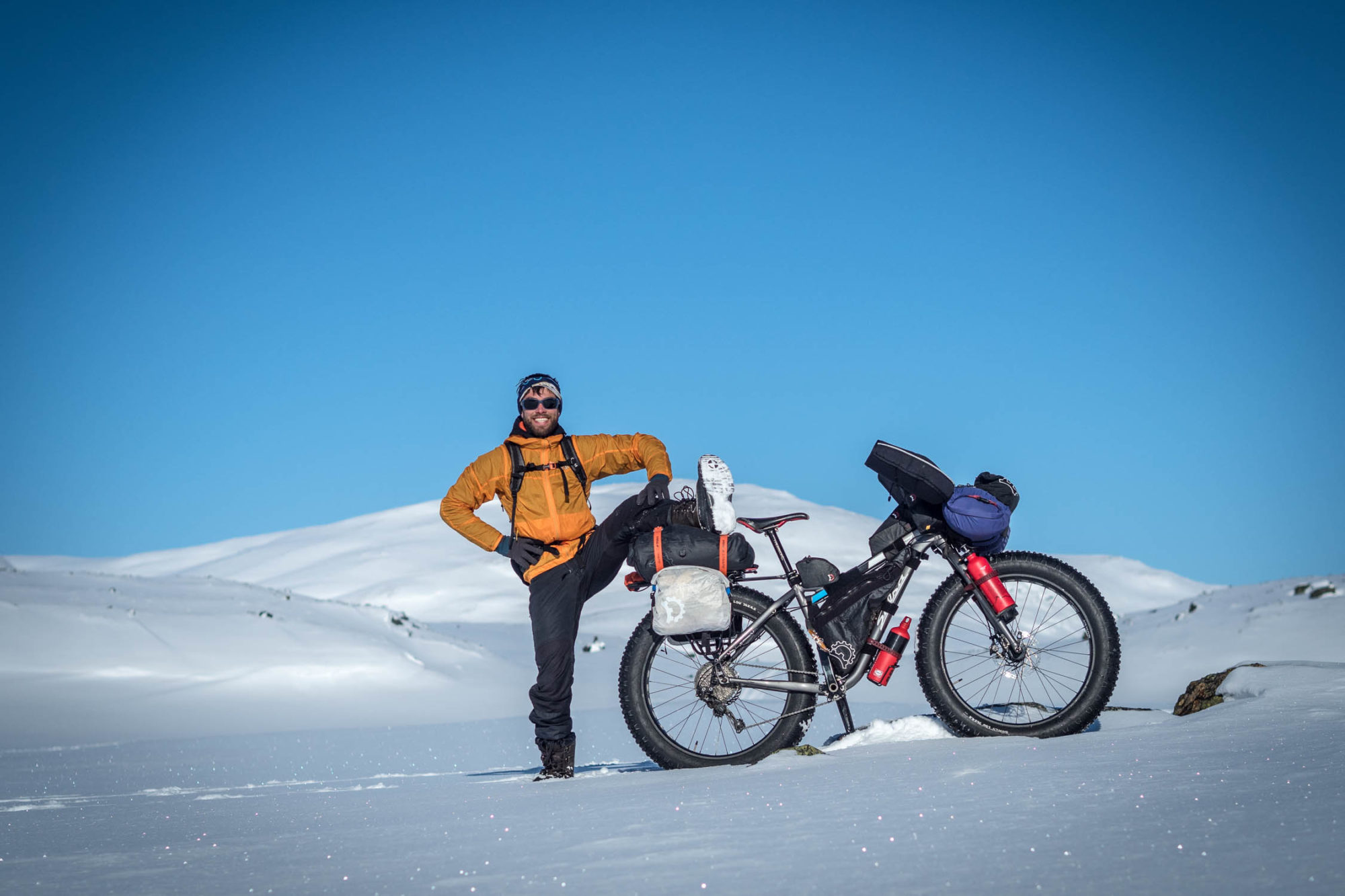
Please keep the conversation civil, constructive, and inclusive, or your comment will be removed.












